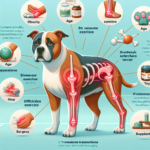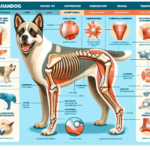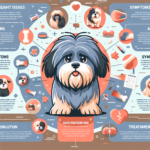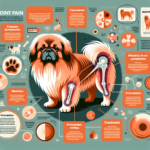Pomeranian Joint Pain: Causes, Symptoms, Prevention, and Treatment
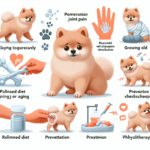
Introduction
The Pomeranian, a small and lively breed, has a rich history and distinctive characteristics that make it a beloved companion. Originating from the Pomerania region in present-day Germany and Poland, these dogs were initially larger and used for herding. Over time, selective breeding reduced their size, resulting in the toy breed we know today. Pomeranians are known for their fluffy double coat, fox-like face, and spirited personality. Despite their small stature, they are bold, intelligent, and often exhibit a larger-than-life attitude.
Like many purebred dogs, Pomeranians are prone to certain health issues. Common concerns include dental problems, heart disease, and joint pain. Joint health is particularly crucial for Pomeranians due to their active nature and the potential for genetic predispositions to joint-related issues.
Maintaining joint health in Pomeranians is essential to ensure they lead a comfortable and active life. Joint pain can significantly impact their quality of life, making it vital for owners to understand the causes, symptoms, prevention, and treatment options available.
Breed-Specific Joint Pain Risks
Genetic Predisposition
Pomeranians, like many small breeds, are genetically predisposed to certain joint issues. Hip dysplasia, although more common in larger breeds, can still affect Pomeranians. This condition occurs when the hip joint doesn’t fit properly into the hip socket, leading to pain and arthritis over time. Additionally, Pomeranians may suffer from patellar luxation, where the kneecap dislocates from its normal position, causing discomfort and mobility issues.
Age-Related Risks
As Pomeranians age, the risk of developing joint pain increases. Arthritis is a common age-related condition that affects the joints, leading to inflammation, pain, and stiffness. Owners should be vigilant as their Pomeranian reaches middle age, typically around 7-8 years old, and monitor for any signs of joint discomfort.
Activity Level and Joint Stress
Pomeranians are energetic and playful, often engaging in activities that can put stress on their joints. While regular exercise is essential for their overall health, excessive jumping or running on hard surfaces can exacerbate joint issues. Owners should balance their Pomeranian’s activity level to prevent undue stress on their joints.
Common Symptoms of Joint Pain in Pomeranians
General Symptoms
Owners should watch for several common symptoms of joint pain in Pomeranians:
- Limping: A noticeable limp or favoring one leg over another can indicate joint pain.
- Stiffness: Difficulty moving, especially after rest, may suggest joint discomfort.
- Reluctance to Move: A Pomeranian that is hesitant to jump, climb stairs, or engage in usual activities may be experiencing joint pain.
- Swelling: Visible swelling around the joints can be a sign of inflammation.
- Behavioral Changes: Increased irritability or changes in behavior can also indicate pain.
Breed-Specific Symptoms
In Pomeranians, specific symptoms may be more noticeable due to their size and build. For instance, a Pomeranian with patellar luxation may frequently skip or hop on one leg. Additionally, their small size makes any limping or stiffness more apparent compared to larger breeds.
When to Consult a Vet
If a Pomeranian exhibits any of the above symptoms for more than a few days, it is crucial to consult a veterinarian. Early intervention can prevent further deterioration and improve the dog’s quality of life. Regular veterinary check-ups are also essential for early detection of joint issues.
Preventive Measures for Joint Health
Exercise Recommendations
Regular, moderate exercise is vital for maintaining joint health in Pomeranians. Activities such as short walks, gentle play, and swimming can help keep their joints flexible without causing excessive stress. Avoid high-impact activities like jumping from heights or running on hard surfaces.
Dietary Suggestions
A balanced diet rich in essential nutrients supports joint health. Foods containing glucosamine, chondroitin, and omega-3 fatty acids can help maintain healthy joints. Owners may also consider supplements specifically designed for joint health, but it’s essential to consult a veterinarian before adding any supplements to their diet.
Weight Management
Maintaining a healthy weight is crucial for reducing joint stress. Excess weight can exacerbate joint pain and lead to other health issues. Owners should monitor their Pomeranian’s weight and adjust their diet and exercise routine as needed to prevent obesity.
Early Screening and Monitoring
Regular veterinary check-ups and early screening for joint issues can help catch problems before they become severe. Vets may recommend specific tests or imaging to monitor joint health, especially as the Pomeranian ages.
Treatment Options for Joint Pain
Non-Surgical Treatments
Several non-surgical treatments can help manage joint pain in Pomeranians:
- Medications: Anti-inflammatory drugs and pain relievers can reduce pain and inflammation.
- Physical Therapy: Exercises and therapies designed to improve joint function and reduce pain.
- Lifestyle Adjustments: Modifying the dog’s activity level and environment to reduce joint stress.
Surgical Options
In severe cases, surgical intervention may be necessary. Common surgeries for joint issues in Pomeranians include:
- Hip Replacement: Replacing a damaged hip joint with an artificial one.
- Patellar Luxation Surgery: Correcting the alignment of the kneecap to prevent dislocation.
- Arthroscopy: A minimally invasive procedure to diagnose and treat joint issues.
Alternative Therapies
Alternative treatments can also benefit Pomeranians with joint pain:
- Acupuncture: Using needles to stimulate specific points on the body to relieve pain.
- Hydrotherapy: Water-based exercises that reduce joint stress while improving mobility.
- Massage: Gentle massage can help reduce muscle tension and improve circulation.
Lifestyle and Management Tips
Daily Care Routine
A consistent daily care routine can help manage joint pain in Pomeranians:
- Regular Exercise: Engage in gentle, low-impact activities daily.
- Balanced Diet: Provide a diet rich in joint-supporting nutrients.
- Weight Monitoring: Regularly check and maintain a healthy weight.
- Joint Supplements: Consider adding vet-approved supplements to their diet.
Modifying the Home Environment
Making the home more comfortable for a Pomeranian with joint pain can significantly improve their quality of life:
- Ramps: Use ramps instead of stairs to reduce joint stress.
- Orthopedic Beds: Provide supportive bedding to alleviate pressure on joints.
- Non-Slip Surfaces: Ensure floors are non-slip to prevent falls and injuries.
Long-Term Management
Long-term management strategies are essential for keeping a Pomeranian active and happy despite joint pain:
- Regular Vet Visits: Schedule regular check-ups to monitor joint health.
- Consistent Routine: Maintain a consistent exercise and care routine.
- Adapt Activities: Modify activities to suit their comfort level and abilities.
FAQs About Pomeranians and Joint Pain
What are the early signs of joint pain in Pomeranians?
Early signs include limping, stiffness, reluctance to move, and behavioral changes. If you notice these symptoms, consult a veterinarian promptly.
Can joint pain in Pomeranians be prevented?
While genetic predispositions cannot be entirely prevented, maintaining a healthy weight, providing a balanced diet, and regular exercise can significantly reduce the risk of joint pain.
Are there specific exercises that are better for Pomeranians with joint pain?
Low-impact exercises like swimming and short, gentle walks are ideal for Pomeranians with joint pain. Avoid high-impact activities that can stress their joints.
What dietary supplements are recommended for Pomeranians with joint pain?
Supplements containing glucosamine, chondroitin, and omega-3 fatty acids can support joint health. Always consult a veterinarian before adding supplements to your dog’s diet.
When should I consider surgery for my Pomeranian’s joint pain?
Surgery should be considered when non-surgical treatments are ineffective, and the dog’s quality of life is significantly impacted. Consult with a veterinarian to determine the best course of action.
Conclusion
Joint pain in Pomeranians is a significant concern that can impact their quality of life. Understanding the causes, symptoms, prevention, and treatment options is crucial for owners to ensure their Pomeranian remains healthy and active. Regular veterinary check-ups, a balanced diet, appropriate exercise, and early intervention can help manage and prevent joint pain. By taking proactive measures, owners can provide their Pomeranians with a comfortable and happy life.

